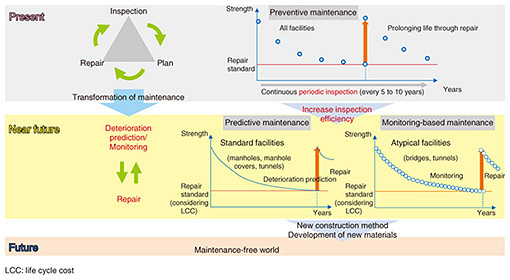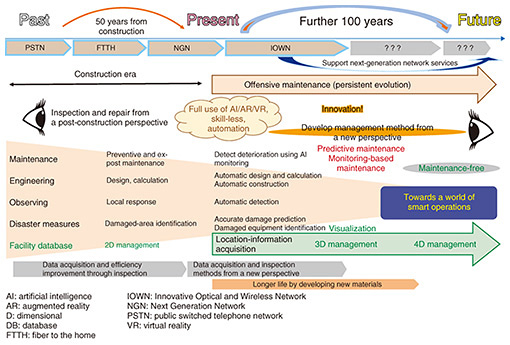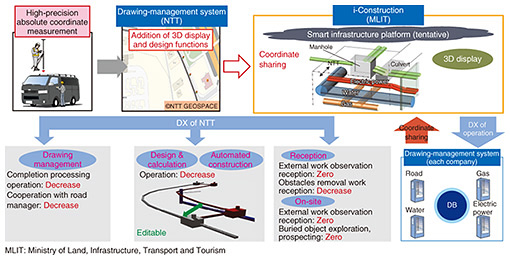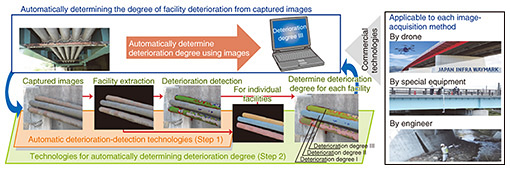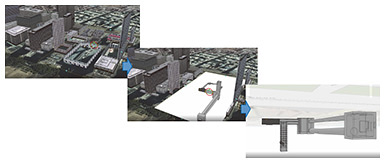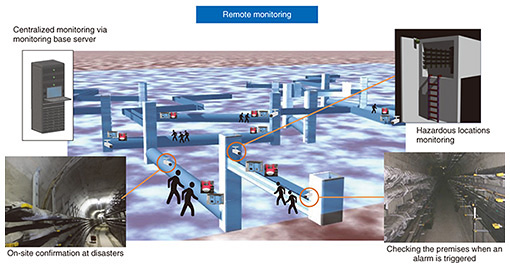 |
|||
|
|
|||
|
Feature Articles: Keynote Speeches/Workshop Lectures at Tsukuba Forum 2019 Vol. 18, No. 4, pp. 43–48, Apr. 2020. https://doi.org/10.53829/ntr202004fa7 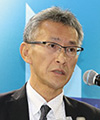 Technical Trends in Infrastructure Maintenance ManagementAbstractIn the Civil System Project of NTT Access Network Service Systems Laboratories, we are working to achieve permanent infrastructure by implementing smart operation of facilities. We introduce new maintenance management for conduits, manholes, and tunnels. This article is based on a lecture from a workshop held on November 1 at Tsukuba Forum 2019. Keywords: degradation prediction technology, high-accuracy location information acquisition technology, 3D model management 1. Direction of maintenance managementNTT has constructed many infrastructure facilities, including underground conduits, manholes, and tunnels. Most of these facilities are over 30 years old and half are more than 50 years old. We have been using the plan-do-check-action cycle of inspection, planning, and repair to extend the life of these facilities. The cycle involves regular inspections that reveal abnormalities, detailed inspections, selection of optimal repair methods according to the inspection results, and repair work. This approach, known as preventive maintenance and post-preservation, is taken only from the post-construction perspective. Repairs are made only after facilities have deteriorated, so it is a rather defensive approach to maintenance management. We ask the question, “What parts deteriorate, when do they deteriorate, and how do they deteriorate?” Knowing the condition of each facility can dramatically change maintenance work. This is a shift towards offensive maintenance. What is most important is technology for predicting deterioration. Deterioration can be accurately predicted by identifying which part is deteriorating and the mechanism by which it is deteriorating, and then estimating the deterioration period. Accurately predicting deterioration makes it possible to manage the state of each facility and perform detailed maintenance tasks such as planned repairs. Although we can expect deterioration of facilities built in the era of mass construction, such detailed planning of repairs can facilitate a leveling effect on construction. That is to say, enabling fine control on the management side will make preservation work greatly different from the conventional approach of waiting until facilities have already deteriorated. Our objective is to change how maintenance work is done. Our approach is described in detail below. 1.1 Maintenance based on prediction and monitoringIt was not previously possible to predict where, how, and when a structure would deteriorate. The basic approach has been to conduct periodic inspections, decide on repairs according to how much the facility’s functionality has decreased, and select the most appropriate repair method for the facility if repair is needed. After repair, however, the cycle of inspection and repair continues, so it has not been possible to determine the deterioration mechanism or supplement parts for which the deterioration-reduction mechanism cannot be identified. We are currently conducting research and development (R&D) on clarifying deterioration mechanisms for infrastructure facilities and have been successful regarding various types of facilities. If mechanisms can be identified, periodic inspections would not be needed to determine what parts to repair and when to repair them. Instead, it is possible to predict deterioration and carry out predictive maintenance. We will be applying this approach to standard facilities such as manholes and manhole covers. However, predicting deterioration in nonstandard facilities, such as specialized bridges and bridge-attached conduits, is difficult, so monitoring-based maintenance will be carried out. Concerning large-scale tunnels, we will move forward with a hybrid system that combines predictive maintenance and monitoring maintenance (Fig. 1).
1.2 Shifting maintenance management from defense to offenseWe have thus far taken measures so that facilities older than 50 years can be used for 100 years or so. We also intend to evolve maintenance management from the conventional defensive approach to an offensive approach to further extend service life so that facilities can be used without concern for 150 or more years (Fig. 2). To achieve this goal, we must take a new technical perspective in developing management methods to replace the conventional inspect-and-repair approach from a post-construction perspective. To achieve an ultimate maintenance-free world, we are moving forward with new innovative R&D regarding construction and repair methods using new materials and inspection methods and creating new databases.
As described above, preventive maintenance based on deterioration prediction and monitoring-based maintenance serve as core technologies and are supported by databases. Because there is a huge amount of data and the role of the database as the foundation for advanced management through the use of various applications, there is a need to evolve from two-dimensional (2D) management on paper towards management in three or four dimensions with a time axis. Database evolution will result in changes in related tasks. For example, 3D management through visualization of underground spaces would make it possible to understand the situation of underground facilities as if a person were on-site and touching them. Previously, it was necessary to look at drawings on paper and imagine the required assembly, but now staff can easily share the same underground space without having such special skills. We call this digital transformation (DX). We are aiming to reduce manual work by combing artificial intelligence (AI), augmented reality (AR), and virtual reality (VR) with advanced database management. For example, the inspection of facility structures requires automation and autonomous operation with robots, etc., so we are pursuing R&D on automated inspection technology using unmanned aerial vehicles, etc. Our R&D also includes application of AI to automatically detect deterioration using digital images taken during inspections as well as damage prediction for infrastructure facilities using a highly accurate 3D database. In engineering, AI-assisted design and assessment and automated machine construction at the worksite are also possible. AR can be used to increase efficiency in on-site inspections, and future advances will enable elimination of on-site inspections. Such 3D databases require highly accurate coordinates, so R&D on highly precise acquisition of location data from a global navigation satellite system (GNSS) is also in progress. 2. R&D on infrastructure2.1 Infrastructure tasks (for conduits and manholes)Correct and accurate location information is needed to increase the efficiency of conduit and manhole work, so technology for acquiring highly accurate absolute coordinates is important. Specifically, using a single-frequency GNSS to measure the location of newly constructed conduits and ground-penetrating radar for locating existing conduits are current R&D topics. Highly accurate acquisition of absolute coordinates would enable sharing of precise facility location information with other lifeline providers in the implementation of the “i-Construction*” measures of the Ministry of Land, Infrastructure, Transport, and Tourism. Doing so would make it possible to automate the construction-completion processing, exclusive-use management, and design and assessment work. It would also lead to more efficient outside inspection work and acceptance of transfer work. In other words, it will lead to the promotion of DX in other companies as well (Fig. 3).
We have been working on using AI for detecting deterioration to improve the efficiency of bridge inspection, and this work is presented in this article as a case study (Fig. 4). Currently, various types of inspection images are acquired by drones, special equipment, or cameras operated by workers, etc. Skilled individuals who determine the degree of deterioration examine images. Our objective is to automate this process so that individuals who do not have specialized skills can do it.
The first step in the process is to distinguish NTT facilities from those of other companies in the obtained images. Then, the NTT facilities are examined for corrosion, and the parts where corrosion exists are identified. It is now possible to detect corrosion with a high probability of success, and we are continuing this work with the goal of automating the determination of the degree of deterioration. Therefore, digital images can be used to determine what facilities are deteriorating, thus increasing efficiency. 2.2 Infrastructure tasks (for tunnels)We are conducting R&D on using 3D models in managing tunnels. This technique visualizes the situation of underground spaces in a manner similar to the street-view function of satellite map services, making it possible to also reference the history of the inspection location (Fig. 5). Workers can view the facilities in 3D with a sense of themselves being in the tunnel. Also, a skeleton view of the tunnel makes it possible to know the placement of the reinforcement bars. For shield tunnels, it is possible to view the state of the primary lining, and any inspection point can be checked in cross-section. Although research is still in progress, it is possible to view from any angle, direction, or cross-section at any time. Implementing this technique will increase work efficiency.
To increase the efficiency of cable-tunnel management, we are currently focusing on three points: 1) full automation of monitoring and inspection using 3D models, 2) central management of facility information using 3D models, and 3) remote support for on-site personnel. Tunnels throughout the country will be monitored at a central monitoring center, and 3D information will be used for viewing facility information (Fig. 6). Also, data on environmental changes, such as temperature and oxygen concentration, in tunnels can be acquired from sensors in real time. Cameras can be used for central monitoring of sites where work may be dangerous and the status of facilities can be checked during natural disasters. The ability to quickly dispatch monitoring capabilities to disaster sites with robots and drones is also desirable.
Unified management of facility information with 3D models is another method of increasing efficiency. Facility-location data are managed as absolute coordinates, making it possible to visualize the situation in cable tunnels in a manner similar to the street-view function of mapping programs, obtain historical data on inspection points and the placement of reinforcement bars, and browse shield segment arrangements. Real-time monitoring with cameras is also possible. Remote support for workers is important because the interior of tunnels is very complicated, especially in Tokyo. Workers who go into tunnels to inspect or repair must be kept informed of environmental conditions, such as temperature, humidity, and oxygen concentration, via real-time communication using tablet devices, etc. Workers can also access the results of past inspections and repair history and determine their current position and the route to the destination from a navigation display on the screen. Emergency evacuation guidance can also be given, the escape direction can be displayed, and communication with the monitoring center is possible, providing support for workers in real time.
3. Future developmentOur objective is to make daily progress in increasing the efficiency of the maintenance management of infrastructure facilities. We also expect that the transformation of databases from 2D to 3D or even 4D will accelerate the DX of business. To continue providing a safe and secure infrastructure, the Civil System Project will promote R&D that creates value through advanced technology in fields such as materials, information, telecommunications, and robotics, and fuse expertise in other fields. We will also contribute to the DX beyond NTT infrastructure facilities in businesses throughout the social infrastructure. |
|||

